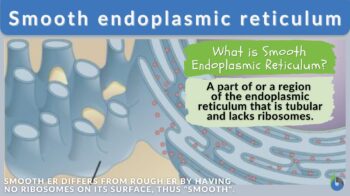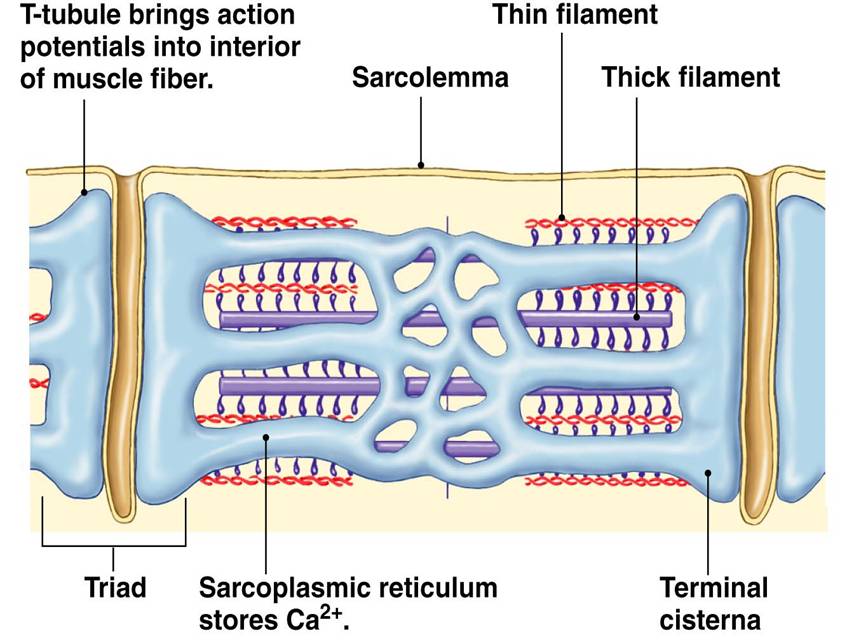
Smooth endoplasmic reticulum
n., plural: smooth endoplasmic reticula
(A part of) endoplasmic reticulum that is tubular in form (rather than sheet-like) and lacks ribosomes
Source: modified by Maria Victoria Gonzaga, BiologyOnline.com, from OpenStax, CC BY 3.0.
Table of Contents
Smooth Endoplasmic Reticulum Definition
Smooth endoplasmic reticulum (sER) is part of or a region in the endoplasmic reticulum that is characterized by having a tube-like structure and generally lacking in ribosomes. It is present in eukaryotic cells and is associated with lipid metabolism and synthesis, carbohydrate metabolism, regulation of calcium concentration, and drug detoxification.
The endoplasmic reticulum (ER) is one of the most prominent organelles of a eukaryotic cell. The ER occurs as an interconnected network of flattened sacs, tubules, and vesicles. The endoplasmic reticulum membrane is connected to the outer nuclear envelope and may also extend to the cell membrane. The endoplasmic reticulum is a multifunctional organelle and many of these functions are dependent on the distinct regions of their location rather than being homogeneously distributed.
There are two types (or regions) of ER: the sER, or the smooth endoplasmic reticulum, and the rER, or the rough endoplasmic reticulum.
- sER is abundant in cells involved in the production of lipids (fats) and steroid hormones, drug detoxification, and calcium metabolism. Examples of such cells are adipose cells, interstitial cells, glycogen-storing cells of the liver, conduction fibers of the heart, spermatocytes, and leukocytes.
- rER is typically found in cells that are active in protein synthesis, e.g., pancreatic cells, liver cells, goblet cells, and plasma cells. It works closely with the ribosomes during the translation of the mRNA transcript, which carries the code regarding the proper sequence of amino acids.
Biology definition:
Smooth endoplasmic reticulum is a part of (or a region in the) endoplasmic reticulum that is tubular and lacks ribosomes. It is associated with lipid synthesis, carbohydrate metabolism, calcium concentration, drug detoxification, and attachment of receptors on cell membrane proteins.
Abbreviation: sER.
Synonyms: agranular endoplasmic reticulum.
Compare: rough endoplasmic reticulum
Discovery of Smooth Endoplasmic Reticulum
ER was one of those organelles to be discovered late despite being one of the largest and functionally important organelles. French cytologist Charles Garnier and others are said to have observed ER under light microscopy as early as 1902. However, their observations were not widely recognized by their contemporaries. The world had to wait another 50 years and it was the advent of electron microscopy that opened the door for two scientists to prove the existence of the endoplasmic reticulum. The American cell biologists Keith R. Porter and George E. Palade, in 1953, observed a net-like (reticulum) structure within (endo) the cytoplasm (plastic) and they named the organelle “endoplasmic reticulum”. By the early 1960s, the structure, composition, and role of the endoplasmic reticulum in muscle contraction and calcium regulation were delineated. In 1971, Günter Blobel (German-born American cellular and molecular biologist) found out that ER plays a central role in the synthesis of proteins.
Structure of the Smooth Endoplasmic Reticulum
The region that lacks ribosomes on its surface is referred to as the smooth endoplasmic reticulum as opposed to the rough endoplasmic reticulum that typically is studded with ribosomes, hence the distinctive names.
The smooth endoplasmic reticulum consists of a membrane-enclosed network of tubules (i.e. wider, tubular, branched elements mainly present near the cell membrane) and vesicles (i.e., the rounded or oval, vacuole-like elements, scattered in the cytoplasm) formed in a reticular pattern that allows for an increased surface area for the action or storage of key enzymes, ions, and metabolites. Its lumen contains various enzymes, calcium ions, and metabolites.
The tubules in sER compared to that of the rER are more variable in diameter and they branch and connect among themselves frequently to form a very compact three-dimensional reticulum, which is essential to the smooth ER functions. In steroid-secreting cells, sER may also take the form of concentric or spiral arrays of highly fenestrated cisternae.
Types of Smooth Endoplasmic Reticulum
Sarcoplasmic reticulum
In muscle cells, a distinct type of smooth endoplasmic reticulum is present which is referred to as sarcoplasmic reticulum. The sarcoplasmic reticulum or SR is a highly specialized form of the smooth endoplasmic reticulum that regulates intracellular calcium homeostasis. It is a network of tubules that extend throughout muscle cells and each segment of the sarcoplasmic reticulum forms a cuff-like structure surrounding a myofibril, the fine contractile fibers that extend the length of the striated muscle cell, wrapping around it but do not come in direct contact with it.

The name sarcoplasmic reticulum literally means “net-like structure found inside the muscle fibers” implying that it is a network of tubules that extend throughout the skeletal muscle cells, wrapping around the myofibrils. It plays an important role in muscle contraction by regulating intracellular Ca2+ concentrations. The sarcoplasmic reticulum acts as a big chamber inside the cell, that stores most of the calcium required for the contraction of muscles.
The sarcoplasmic reticulum is divided into two domains based on the nature of their functions: the longitudinal sarcoplasmic reticulum and the junctional sarcoplasmic reticulum (terminal cisternae). The longitudinal sarcoplasmic reticulum is a network of many interconnected tubules around each myofibril. The longitudinal tubules join at their ends to form a single dilated sac-like formation which is called terminal cisterna. Both the longitudinal and the junctional sarcoplasmic reticulum show a specific spatial organization with respect to the myofibrils, being regularly aligned with specific regions of the sarcomeres.
The entrance doors to the sarcoplasmic reticulum are named SERCA while each cisterna carries sets of closely grouped structures known as ryanodine receptors that function as the exit doors. The calcium stored in the sarcoplasmic reticulum is released with the help of ryanodine receptors which initiate muscle contraction and during relaxation, calcium is stored back inside the sarcoplasmic reticulum with the help of SERCA, which is a pump that transports calcium ions from the cytoplasm into the sarcoplasmic reticulum.
There are also terms used to refer to smooth endoplasmic reticulum named after their functions or location, for example, the smooth endoplasmic reticulum of steroid hormone-producing cells (or “smooth endoplasmic reticulum of endocrine cells”). Such ER is not necessarily a subtype of smooth ER (as sarcoplasmic reticulum is); rather, it is a special name used as a specific reference to smooth ER in cells of endocrine glands specializing in hormonal production and regulation. This smooth ER is particularly involved in producing steroid hormones, including steroid precursors, such as cholesterol. It is also involved in steroid hormone metabolism, such as the conversion of pregnenolone to progesterone.
Location and Presence
The smooth endoplasmic reticulum is present in almost all eukaryotic cells. However, some eukaryotic cells lack sER, such as ova, embryonic cells, and mature RBCs. Conversely, some specialized cells, are rich in sER. Examples of cells with abundant sER are sebaceous glands, gonadal cells (the steroid-secreting cells, such as Leydig cells in the testis and follicular cells in the ovary) involved in producing steroid hormones and other hormones of the endocrine system, hepatocytes in the liver, and cells of striated muscles.
Smooth Endoplasmic Reticulum Functions
sER plays a crucial role in cellular metabolism. The diverse metabolic processes where sER is involved varies according to the cell type and they are found abundant in certain cell types that rely heavily on sER functions.
The major functions of sER include lipid synthesis, carbohydrate metabolism, regulation of intracellular calcium concentration, and drug detoxification. sER contains a wide range of enzymes involved in the synthesis of lipids, especially the biosynthesis of phospholipids and steroids.
The cells involved in the secretion of these products, such as those in the testes, ovaries, and skin oil glands have a great amount of sER.
sER also plays a key role in cholesterol homeostasis. Even though the cholesterol synthesized by the endoplasmic reticulum is very low, most of the molecular machinery that regulates cellular cholesterol homeostasis resides within it.
The smooth endoplasmic reticulum is also involved in the transfer of molecules produced in the rough ER to the Golgi complex.
Lipid synthesis
The smooth endoplasmic reticulum is the major site for lipid synthesis, particularly at the membrane contact sites (MCS). MCS are areas where ER membranes make close contact with other cytoplasmic organelles, such as the Golgi apparatus, mitochondria, lysosomes, peroxisomes, endosomes, chloroplasts, and plasma membrane, and allow the transfer of substances.
The endoplasmic reticulum (ER)‐localized enzymes present in these sites of sER are responsible for the synthesis of the vast majority of cellular lipids. The sER, therefore has a major role in balancing different categories and classes of lipids, thereby influencing the cellular lipid biomass. These ER‐localized enzymes present in sER are initiated by signals from outside and inside the cell. The cellular lipids synthesized by the sER provide the cell with membrane lipids essential for the growth and differentiation‐based changes in the morphology and structure of the cell. They also help to maintain membrane homeostasis across the cell.
The membrane-contact site between ER and mitochondria is involved with the synthesis of phospholipids. Phospholipids primarily create barriers in cellular membranes to protect the cell and the organelles. They are also involved in the regulation of cellular processes related to growth, immune surveillance, and synaptic transmission. Phospholipids also play a major role in the nonvesicular lipid transportation between the ER and other organelles.
Ceramides are a family of waxy lipids that play a key role as a structural element of the cell. They are also crucial in cellular signaling, cell cycle, cell senescence, cell migration, and adhesion. Ceramides are synthesized in the sER. They are transported from sER to Golgi as a component of the transport vesicle membrane.
sER also contains enzymes that are involved in the synthesis of sterols and steroids. Steroid hormones synthesized in the smooth endoplasmic reticulum are lipophilic and cannot be stored in vesicles from which they would diffuse easily, and hence they are synthesized when needed as precursors. Among the steroids produced by the SER in animal cells are the sex hormones of vertebrates and the various steroids secreted by the adrenal glands. The cells that synthesize and secrete these hormones, for example, the cells in the testes and ovaries are rich in the smooth endoplasmic reticulum.
Carbohydrate metabolism
Glucose is the main source of energy in eukaryotes. Organisms have evolved capabilities to metabolize glucose from other non-carbohydrate precursors in the absence of glucose. The synthesis of glucose from non-carbohydrate precursors like pyruvate, oxaloacetate, succinate, lactate, etc. is known as gluconeogenesis. These non-carbohydrate precursors undergo several processes where they are converted from one intermediate compound to another, in the presence of several enzymes in multiple steps.
In most tissues, the final compound formed is glucose 6-phosphate and free glucose is not generated. Glucose 6-phosphate cannot diffuse out of the cell, therefore it is stored inside the cell. This in turn paves the way for the regulation of glucose effectively. A special enzyme called glucose 6-phosphatase which is produced by the smooth endoplasmic reticulum is required to hydrolyze glucose 6-phosphate into glucose. This enzyme is only present in tissues of the liver and kidney, where they are involved in the maintenance of blood glucose homeostasis. In these tissues, glucose-6-phosphate is transported to the lumen of the smooth endoplasmic reticulum and finally converted into glucose by the action of the glucose-6-phosphatase enzyme.
Regulation of calcium ion concentrations
The smooth endoplasmic reticulum plays a key role in calcium homeostasis. It is responsible for calcium ion storage and release. In muscle cells, for example, a special type of smooth endoplasmic reticulum is referred to as sarcoplasmic reticulum. The sarcoplasmic reticulum plays an important intracellular calcium buffer zone. When the muscle cells are stimulated by a nerve impulse, calcium ions rush across the membrane of the endoplasmic reticulum into the cytosol and trigger the contraction of muscle cells. In other cell types, calcium ions released from the smooth endoplasmic reticulum trigger responses, such as the secretion of vesicles carrying newly synthesized proteins.
Drug detoxification
Cytochrome P450s are a large family of enzymes resident in the membrane of the smooth endoplasmic reticulum. These enzymes of the smooth endoplasmic reticulum help detoxify drugs and poisons, especially in liver cells. Detoxification by smooth ER usually involves adding a hydroxyl group to drug molecules, thus making them more soluble and easier to flush from our bodies. The sedative phenobarbital and other barbiturates are examples of drugs metabolized by the smooth endoplasmic reticulum in this manner by adding a hydroxyl group. Drugs like barbiturates, alcohol, and many others can induce the proliferation of the smooth endoplasmic reticulum and its associated detoxification enzymes, thus increasing the rate of detoxification. This, in turn, increases the tolerance of the drug, meaning that higher doses are required to achieve a particular effect such as sedation. Also, because some of these detoxification enzymes present in smooth endoplasmic reticulum have broad actions, the proliferation of the SER in response to one drug can increase the need for a higher dosage of other drugs as well.
Unfolded protein response
While the rough ER is primarily involved in protein production and protein folding, it is also involved in protein folding quality control. When there is an imbalance in the protein folding capacity and the protein load, an ER stress response ensues. Such a response is referred to as the unfolded protein response (UPR response) triggered by the misfolded protein accumulation in the ER lumen. ER would then be concerned with translocating them from the lumen to the cytosol for degradation. For the mechanism and further info regarding UPR response, read here. As for the role of smooth ER in UPR response, it participates by releasing calcium ions to activate the UPR signaling pathway (e.g., by activating ER stress sensors such as the inositol requiring enzyme 1, IRE1) when misfolded proteins accumulate in the lumen and by providing lipids and metabolites for use in the quality control processes.
Disorders Caused by Dysfunctional sER
Von Gierke disease
The Von Gierke disease or Type 1 Glycogen Storage Disease (GSD I) is one of about a dozen diseases that affect glycogen metabolism. The disease causes chronic low blood sugar and abnormal growth and is fatal in many cases. This disease is due to a genetic deficiency of glucose-6-phosphatase, an enzyme present in the smooth endoplasmic reticulum. The sER contains the enzyme glucose-6-phosphatase which converts glucose-6-phosphate to glucose, an important step in gluconeogenesis. Patients with this disease are able to store glycogen but cannot break it down and eventually with time glycogen accumulates, which gets stored in the liver and kidneys. causes enlargement of the liver. This eventually leads to a fatty liver from non-alcoholic fatty liver disease in GSD I patients. Von Gierke disease is inherited in an autosomal recessive manner and has an incidence of approximately 1 in 100,000 births in the American population as per some studies. This disorder was first described by Von Gierke in 1929 and is named after him.
Cytochrome P450 oxidoreductase deficiency (PORD)
Cytochrome P450s reductase is a membrane-bound enzyme found in the smooth endoplasmic reticulum. This is a rare disorder caused by the deficiency of the enzyme Cytochrome P450s reductase. This disorder affects steroid hormones, which are essential for normal development and reproduction and affects the development of the skeletal system, reproductive system, and many other parts of our body. The symptoms and signs of cytochrome P450 oxidoreductase deficiency vary from mild to severe. People with moderate forms of the disorder may have ambiguous genitalia and be infertile. The most severe form of the disorder is called Antley-Bixler syndrome. Antley-Bixler syndrome is characterized by skeletal abnormalities, particularly involving bones in the head and face, these include craniosynostosis (premature fusion of the skull bones), a flattened midface, a prominent forehead, and low-set ears.
Discover more about the difference between the smooth endoplasmic reticulum (SER) and the rough endoplasmic reticulum (RER).
Try to answer the quiz below to check what you have learned so far about the smooth endoplasmic reticulum.
References
- Alberts B, Johnson A, Lewis J, Raff M, Roberts K, Walter P (2002). Molecular biology of the cell (4th ed.). New York: Garland Science.
- Verma, P. S., & Agrawal, V. K. (2006). Cell Biology, Genetics, Molecular Biology, Evolution & Ecology (1 ed.). S .Chand and company Ltd.
- Cooper GM (2000). The cell: a molecular approach (2nd ed.). Washington (DC): ASM Press.
- Lodish H, et al. (2003). Molecular Cell Biology (5th ed.). W. H. Freeman. pp. 659–666.
- Alberts, B. (2004). Essential cell biology. New York, NY: Garland Science Pub.
- Muthu Periasamy, Anuradha Kalyanasundaram (2007). SERCA pump isoforms: their role in calcium transport and disease
©BiologyOnline. Content provided and moderated by BiologyOnline Editors.






